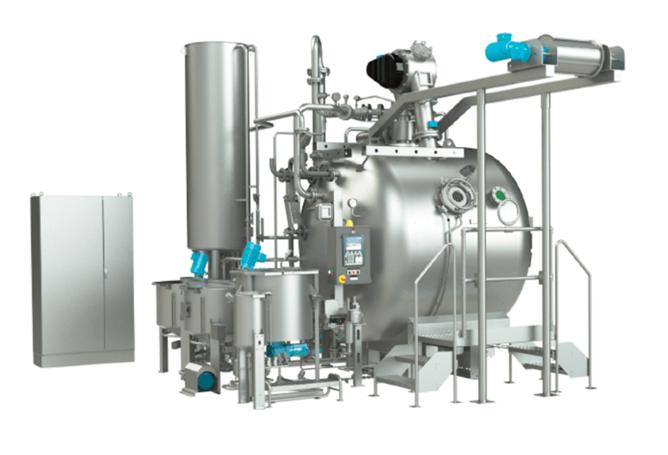
3 minute read
Thies: Signature technology transforms dyeing
Thies will exhibit the Signature Series, at Hall H11, booth B208, thus opening a new chapter in fabric coloration for the first time. Signature technology transforms dyeing as we know it, but it is plug-in ready for existing dye houses.
With its novel ability to precisely dose concentrated chemistries and flexibly use less water to transport fabric, the Signature Series is capable of delivering highly consistent results with liquor ratios starting at 1:2.3 liter of water per 1 kg of fabric. Proven in bulk production, water consumption is reduced, with improved dyeing uniformity and shorter batch times.
Advertisement
Signature‘s ultra-low liquor ratio has further multiple cost and environmental benefits. Dye consumption is reduced up to 20% while achieving the same shade, less energy is required for heating water, and the treatment of water is less costly because the total dissolved solids (TDS) is reduced upto 50%.
Unlike pad or spray dyeing, with Signature there is no need to have separate machines for washing, bleaching and dyeing because nearly all wet treatments can be carried out on this single machine. There is no intermediate handling and drying, and there is no endto-end variation associated with wet-on-wet pad-bath dilution.
Color uniformity is improved over pad dyeing because fabric passes through the nozzle 60+ times versus a single nip, and there is no side-center-side variation caused by pad roll wear or crowning. A wide array of fibre types and fabric structures can be successfully processed, including woven fabrics, warp knits, spacers, and circular knits.
In short, the Signature Series has the proven advantages of batch dyeing while competing with the low liquor ratio of single-pass applications. The ease with which Signature technology fits into existing production lines means payback on investment starts on day one.
Transparency and Digitalization
Thies offers several tools for digitalization, reporting, and process control. Energy Control, pH-control, conductivity measurement, and DyeControl are tools for optimizing recipes and process settings. Visual representations of the process curves enable both a control of the turbidity and a determination of the dye extract from the liquor. Thies measures the process and provide intuitive reports that aid decision making in high quality dyeing.
Automation
The need for automation is evergrowing, and its advantages are diverse. Automation offers increased productivity through reduction of wait times, stable quality, improved occupational safety, a more inviting workplace, and freedom from constraints caused by labor shortages.
An automated storage, weighing and dispensing system for dyestuffs and / or auxiliary chemicals comes with many advantages:
Workers no longer have routine contact with chemicals and dyes during weighing, transportation, dispensing, and dosing.
Tasks that do not add value are elimi- nated, and the workplace is safer. The dangers of falling or spilling chemicals and dyes are minimized, protecting workers and the environment from harm.
The digital storage system manages the exact stock levels and generates order proposals if the stock falls below the defined safety level.
A supervisory production planning system, centrally hosted, controls the process organization of the complete dye house by bidirectional communication. The MPS systems (Multi Product Supply systems) monitor the delivery destinations (tanks). The synchronization ensures an optimal process and production sequence. MPS systems integrate themselves seamlessly into the concept of a future-oriented, efficient dye house, delivering large increases in productivity and quality.
At the same time, the automatic weighing, dissolving and provision of dyes and chemicals leads to increased dyeing quality results, maximum reproducibility, savings of human resources, significantly increased occupational and environmental safety, as well as optimized consumption of products.
Today, there are solutions for smaller dye houses that work self-sufficiently, and modularity offers a manageable, affordable, step-wise improvement for larger dye houses.
As a system provider, Thies also offers holistic solution concepts. An example is the automated loading and unloading of package carriers. The package carriers are prepared automatically using intelligent robot technology, so that there are no waiting times and the time-consuming and physically strenuous manual work is no longer necessary. In addition, the yarn packages and locking devices are loaded and unloaded or locked much more gently.
Thies automation solutions are no longer limited to the dyehouse, the company also offers custom solutions for fabric finisher and the coating industry.
Circular economy
Wastewater and its thermal energy are valuable resources. Thies has an ozone system in its portfolio that can be used to decolorize colored waste water. The use of active oxygen splits the organic and inorganic impurities. The oxidized dye molecules become colorless. The result is a colorless solution which can be recycled for reuse in the process.
Heated waste water is a regenerative energy source. Transferring its energy to cold water reduces primary energy consumption as well as CO2 emissions. The use of Thies‘ intelligent heat recovery systems enables a significant reduction in production costs and makes a major contribution to efficient, clean and energy-saving production.
In addition to global market forces, the European Green Deal demands that, by 2030, textile products placed on the EU market are long-lived and recyclable, to a great extent are made of recycled fibres, are free of hazardous substances, and are produced in respect of social rights and the environment. With expertise in industrial-scale production of pressure vessels and automated material handling equipment, Thies supports solutions for both removal and re-dyeing of recycled fibres and yarns.










